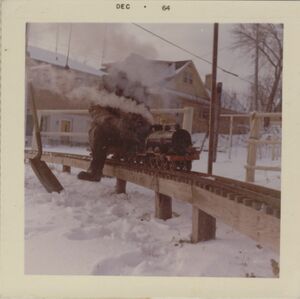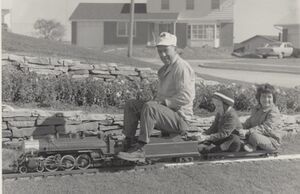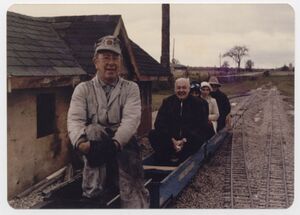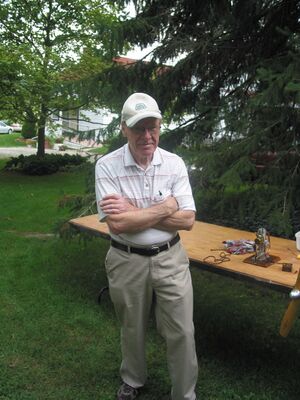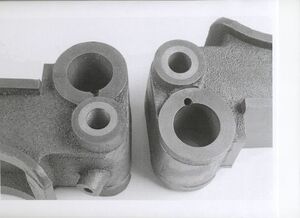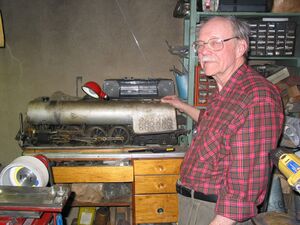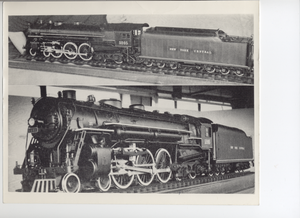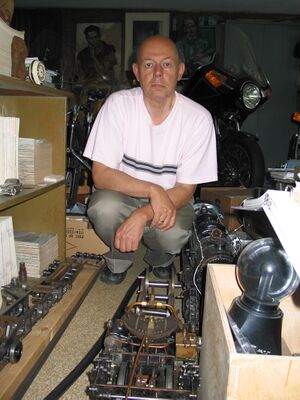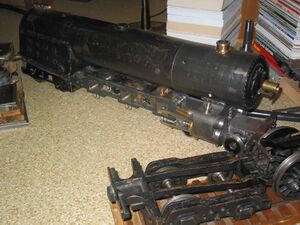The Hoffman Hudson Story
By Don Carr, April 2021
There is a saying that truth can be stranger than fiction. This is certainly the case with Carl Hoffman, the supplier of the Hoffman Hudson and how he got involved in the hobby. Literally, it all started by accident. A car accident.
The story starts in 1958 when Carl was involved in a serious car accident. As part of the settlement from the accident he received a sum of money. While he was recovering from his injuries and still had time on his hands, he took a trip to England to visit friends and have a look around. At one point, he ended up at the live steam locomotive and model supplier Bassett-Lowke. While there, they said he should visit Stapleford Park and see the Stapleford 10-1/4 inch gauge miniature railway. Carl went to see what live steam locomotives were all about and that’s where he got the live steam bug.
When Carl returned from his trip to England, someone in Niagara Falls had a Heilan Lassie for sale in ¾ inch scale and Carl bought the model. Carl then built a 3.5 inch gauge model locomotive track in his backyard on Edna Street in Kitchener, Ontario where he was living at the time. In 1965 Carl moved from Edna Street to Thornridge Crescent also in Kitchener.
Around 1967 Carl met James Turnbull from Montreal at one of the club meets in Toronto. Jim sparked Carl’s interest in the larger gauge locomotives. Carl approached Pioneer Village in Doon to build a 7.25 inch gauge track. His proposal was accepted and eventually an 1100 foot long track was constructed. The track was started in late 1968 and finished in 1969. When the park was expanded and a firehall built on the track site, Carl moved from Doon to St. Agatha in 1972. A new 7.25 inch gauge track was constructed on a rented 5 acre site located in the country. The photo of Carl is at St. Agatha in 1975.
The first time I visited Carl was in his workshop on Thornridge in October 1985. I had just purchased a partially built Hoffman Hudson from Miniature Power Products and needed some additional castings to work on the model. I can remember Carl and his son Bruce had a nearly complete Hudson they had made for sale sitting on the bench and in retrospect, I should have bought it.
In 1985 Carl passed away. Carl was a member of COALS (Central Ontario Association Live Steamers) which still exists today. Carl worked first as a machinist in Dominion Electrohome (later Electrohome) and then in the engineering department.
As a historical note, the Hoffmann brothers came to Canada in 1842 from southwest Germany. The two brothers John and Kuhnrod were unmarried at the time. Kuhnrod went on to Michigan and became a farmer. John, Carl’s great, great grandfather remained in Canada and was a steeple jack. When the two brothers arrived here, the double “nn” on their name was dropped.
But before we can go further, we have to go back in time. Back to the early 1950’s.
At that time, someone in Detroit started making loose patterns and model drawings for a NYC Hudson which was never completed. Frank Birch, a Canadian, who was living in Essex County (Essex County is located near Windsor, Ontario) at the time took over the project and finished the set of patterns. Birch then made a beautiful detailed Hudson from the patterns.
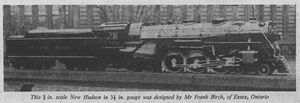
Frank Birch also sold drawings and castings for his Hudson and an unknown number of Hudsons may have been built using the original Birch castings and drawings. One can tell an original Birch casting as all of the original loose pieces were stamped “Birch”. I am very fortunate to have a few of the original castings myself which were given to me by Bruce Hoffman.
Starting way back in the late 1920’s Frank Birch was advertising O-gauge and and 1/2 inch scale American type locomotives as well as a range of other live steam engines and fittings in The Modelmaker from his address at Hazel Park Station in Royal Oak, Michigan. In the early 1930’s he began to advertise a “New Hudson” type passenger locomotive in 3/4 inch scale.
In the October 26, 1933 Issue of the Model Engineer and Practical Electrician there is a substantial article by LBSC describing a new 3/4 inch scale NYC J-1a/b 5200 Hudson design by J. A. (Alex) Josslin of Toronto, Canada. In the article, it is stated by LBSC that Frank Birch “can supply Canadian and American builders direct with everything they need” in relation to this design.
It is not known if this was the start of the Hoffman Hudson as the Hoffman and Josslin designs are quite different requiring different patterns to be made.
Frank Birch later moved from the USA to Canada in the early 1950’s where he worked for General Motors in Windsor in the plant toolroom. He died in Essex, Ontario in 1982. He was 93. For many years he ran his locomotives on the Sun Parlour Lines track in Windsor. Frank Birch built quite a few other locomotives besides the NYC Hudson, mostly to English designs.
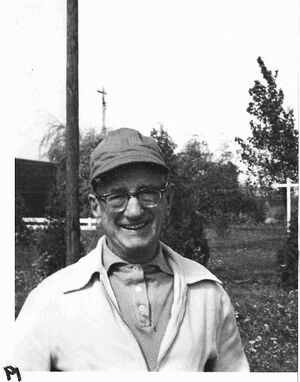
Carl bought the finished set of loose patterns and drawings from Frank Birch in the fall of 1964 and started the work of putting them on matchplates as local foundries had stopped casting from loose patterns. This effort took quite a while and it was only in 1968-69 when the conversion to matchplates was complete. Carl started advertising the Hoffman Hudson in the early 1970’s in Live Steam and 1983 was the last year he advertised there. For a couple of years in the 1970’s Carl advertised in the Model Engineer as well. Bruce Hoffman recollects that about 25 complete sets of plans and castings were sold. Many more drawing sets and individual castings were sold (such as drivers and cylinders) presumably to persons building to their own designs or were adapted to other Hudson model locomotives such as the CPR or CNR Hudsons.
The Hoffman Hudson enjoyed international as well as domestic success. Four complete casting sets went to Australia, three to Germany and two to Italy. Many more casting sets were sent to the United States, particularly to New York State and the State of Massachusetts, than were sold in Canada. Of the casting sets sold domestically, most were in Ontario. Strangely, although Carl advertised the NYC Hudson extensively in the UK, Bruce doesn’t remember having any success there.
Carl was always very customer oriented and one could buy as little or as much as one wanted. I remember that I benefited from this as I made several casting purchases over the years as the project I was working on progressed.
The Hoffman New York Central Hudson was based on the early 1927-29 J-1B series Hudsons having Walschaert valve gear. Some of the parts were simplified to make construction easier. Twenty two (22) individual unnumbered drawings constitute a basic compete set. However, Carl and Bruce did produce additional individual sketches in response to requests from individual customers adding additional details. I have a number of these sketches. On many of the drawings is the name W.P. Levon. Levon’s name appears to be associated with the original drafting done in Detroit as Bruce Hoffman recollects that neither Carl Hoffman nor Frank Birch had any dealings with this person. Carl received a set of paper prints only when he took over the project from Frank Birch. Carl had to reproduce all of the paper drawings on Mylar. Bruce recalls that this was quite an exercise all on its own.
More than half of the Hoffman Hudson model boilers I have come across are all welded mild steel boilers even though the Hoffman drawings show an all copper boiler. The steel boilers for the Hoffman Hudson were produced by Reg. Miller of St. Thomas, Ontario. Carl likely met Reg. at The Golden Triangle Model Engineers exhibition held in the Lambeth arena around 1968. Reg. asked Carl if he had anyone who could make the boiler. At the time, Carl was in touch with a Montreal contact who was interested in producing the copper Hoffman boiler but nothing ever developed from this.
Reg. offered to build the Hoffman boiler in steel so whenever a customer wanted a ready-made boiler, Carl would put them in contact with Reg. Reg. recalls that about 20 steel boilers were constructed. Most or all of the steel boilers were built in the 1970’s.
At the time, Reg. Miller worked for Clark Forklift in St. Thomas in the engineering department. He had access to the manufacturing facilities for bending and welding. The steel boilers were made exactly to the Hoffman copper boiler print. Reg. never had a Hoffman Hudson himself but he did, once, complete a partially built Hoffman Hudson which utilized his boiler. Reg. also fabricated a couple of Hoffman Northern boilers which were in effect stretched Hudson’s. All that exists of this little known design is a Northern frame pattern which is in the possession of the author, all other components being standard Hudson parts.
All of the brass/bronze castings used in the Hoffman Hudson were produced at the Riverside foundry located in New Hamburg. The foundry still exists today although now it is a lot bigger. All of the iron castings were produced in the Link Belt foundry located in Elmira. The Link Belt foundry is no longer in existence.
On the original boiler drawing, a hollow staytube throttle is shown. Later, a smokebox rotary throttle was added as an alternative as it was simpler to construct and Carl found out that the hollow stay tube throttle sometimes stuck open or didn’t shut off completely when closed. On the Hoffman Hudson which I have, there is a slightly modified rotary throttle having what I will call the “Dave Powell notch”. A shallow “v” is filed or milled into the leading edge of the barrel of the throttle to allow steam to fill the cylinders just before starting.
Customers could also order mostly machined cylinders if they so wished in addition to the cylinder castings. The machine work done on the cylinders was undertaken by Ross Allemang of Kitchener, Ontario. He was a Tool and Die maker by trade but is now retired.
Ross’ notes indicate that 17 full sets of cylinders were machined for Carl Hoffman between 1979 and 1987. At the time Ross did all of the layout and cylinder machining on his 10.75” swing Matthew Moody & Sons center lathe and a 7” Atlas shaper.
Ross also has under construction a very detailed Hoffman Hudson. To date, only the engine has been made. The boiler on the engine is all steel but has rolled in copper tubes.
The Hoffman Hudson design, although not marketed today, still exists. Bruce Hoffman retained all of the original patterns and drawings. As of November, 2009, Don Carr of the Toronto Society of Model Engineers (TSME) purchased everything which remained in ¾ inch scale including the complete Hoffman Hudson design, drawings, patterns, castings and passenger car equipment. Besides the Hudson, there were other patterns and castings included, all in 3/4 inch scale. He plans to continue the tradition started by Frank Birch and developed by Carl Hoffman.
Don has said he can help anyone working on or who has a partially completed Hoffman Hudson. He may be reached at carrdo66@gmail.com
For the past several years, Don has been describing the construction of both Hoffman and Josslin type NYC Hudson’s and Hudson related topics in 3/4 inch scale on the web under the author name of “carrdo”. See http://www.chaski.org/homemachinist/. Look under “Live Steam”.
Carl and Bruce were involved with and had many additional locomotives besides the ¾ inch scale Hoffman Hudson. There was the ¾ inch scale Baltimore and Ohio P-7 Pacific, the ¾ inch scale Fred Bohn Union Pacific 4-6-6-4 articulated Challenger and Bohn’s 1-1/2 inch scale, 7.25 inch gauge NYC 999, the Roedding/Douglas 1-1/2 inch scale, 7.25 inch gauge NYC J-1e Hudson, the 1-1/2 inch scale, 7.25 inch gauge CNR U2c Northern, the 1-1/2 inch scale, 7.25 inch Gauge Grand Trunk American and several 1-1/2 inch scale, 7.25 inch gauge diesel locomotives and much passenger car equipment but that is another story entirely.
